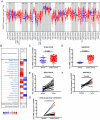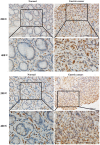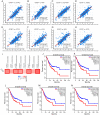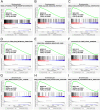Increased IGFBP7 Expression Correlates with Poor Prognosis and Immune Infiltration in Gastric Cancer
- PMID: 33531979
- PMCID: PMC7847654
- DOI: 10.7150/jca.50370
Increased IGFBP7 Expression Correlates with Poor Prognosis and Immune Infiltration in Gastric Cancer
Abstract
Background: Insulin-like growth factor binding protein-7 (IGFBP7) contributes to multiple biological processes in various tumors. However, the role of IGFBP7 in gastric cancer (GC) is still undetermined. The study aims to explore the role of IGFBP7 in GC via an integrated bioinformatics analysis. Methods: IGFBP7 expression levels in GC and its normal gastric tissues were analyzed using multiple databases, including the Tumor Immune Estimation Resource (TIMER), Oncomine, The Cancer Genome Atlas (TCGA) and Gene Expression Omnibus (GEO) databases, as well as by our clinical gastric specimens. The methylation analysis was conducted with MEXPRESS, UALCAN and Xena online tools. The survival analysis was conducted using the Kaplan-Meier Plotter and Gene Expression Profiling Interactive Analysis (GEPIA) databases. Coexpressed genes of IGFBP7 were selected with the cBioPortal tool and enrichment analysis was conducted with the clusterProfiler package in R software. Gene set enrichment analysis (GSEA) was performed to explore the IGFBP7-related biological processes involved in GC. Correlations between IGFBP7 and immune cell infiltrates were analyzed using the TIMER database. Results: IGFBP7 expression was significantly upregulated in GC and correlated with stage, grade, tumor status and Helicobacter pylori infection. High IGFBP7 expression and low IGFBP7 methylation levels were significantly associated with short survival of patients with GC. Univariate and multivariate analyses revealed that IGFBP7 was an independent risk factor for GC. The coexpressed genes LHFPL6, SEPTIN4, HSPB2, LAYN and GGT5 predicted unfavorable outcomes of GC. Enrichment analysis showed that the coexpressed genes were involved in extracellular matrix (ECM)-related processes. GSEA indicated that IGFBP7 was positively related to ECM and inflammation-related pathways. TIMER analysis indicated that the mRNA level of IGFBP7 was strongly correlated with genes related to various infiltrating immune cells in GC, especially with gene markers of tumor associated macrophages (TAMs). Conclusions: Increased IGFBP7 expression correlates with poor prognosis and immune cell infiltration in GC, which might be a potential biomarker for the diagnosis of GC.
Keywords: IGFBP7; bioinformatics analysis; gastric cancer; immune infiltration; prognosis.
© The author(s).
Conflict of interest statement
Competing Interests: The authors have declared that no competing interest exists.
Figures







Similar articles
-
BICC1 as a novel prognostic biomarker in gastric cancer correlating with immune infiltrates.Int Immunopharmacol. 2020 Oct;87:106828. doi: 10.1016/j.intimp.2020.106828. Epub 2020 Jul 28. Int Immunopharmacol. 2020. PMID: 32736193
-
LAYN Is a Prognostic Biomarker and Correlated With Immune Infiltrates in Gastric and Colon Cancers.Front Immunol. 2019 Jan 29;10:6. doi: 10.3389/fimmu.2019.00006. eCollection 2019. Front Immunol. 2019. PMID: 30761122 Free PMC article.
-
Effect of LAMA4 on Prognosis and Its Correlation with Immune Infiltration in Gastric Cancer.Biomed Res Int. 2021 Aug 9;2021:6428873. doi: 10.1155/2021/6428873. eCollection 2021. Biomed Res Int. 2021. PMID: 34414238 Free PMC article.
-
Identification of GGT5 as a Novel Prognostic Biomarker for Gastric Cancer and its Correlation With Immune Cell Infiltration.Front Genet. 2022 Mar 18;13:810292. doi: 10.3389/fgene.2022.810292. eCollection 2022. Front Genet. 2022. PMID: 35368661 Free PMC article.
-
Tumor Endothelial Marker TEM7 is a Prognostic Biomarker and Correlating with Immune Infiltrates in Gastric Cancer.Int J Gen Med. 2021 Dec 22;14:10155-10171. doi: 10.2147/IJGM.S347010. eCollection 2021. Int J Gen Med. 2021. PMID: 34992436 Free PMC article.
Cited by
-
Molecular pathway of anticancer effect of next-generation HSP90 inhibitors XL-888 and Debio0932 in neuroblastoma cell line.Med Oncol. 2024 Jul 3;41(8):194. doi: 10.1007/s12032-024-02428-z. Med Oncol. 2024. PMID: 38958814 Free PMC article.
-
Proteomic Signatures of Diffuse and Intestinal Subtypes of Gastric Cancer.Cancers (Basel). 2021 Nov 25;13(23):5930. doi: 10.3390/cancers13235930. Cancers (Basel). 2021. PMID: 34885041 Free PMC article.
-
The heterogeneous roles of neutrophils in gastric cancer: scaffold or target?Cell Mol Biol Lett. 2025 Jun 16;30(1):71. doi: 10.1186/s11658-025-00744-4. Cell Mol Biol Lett. 2025. PMID: 40524157 Free PMC article. Review.
-
IGFBP7 promotes gastric cancer by facilitating epithelial-mesenchymal transition of gastric cells.Heliyon. 2024 May 9;10(10):e30986. doi: 10.1016/j.heliyon.2024.e30986. eCollection 2024 May 30. Heliyon. 2024. PMID: 38778944 Free PMC article.
-
Insulin like growth factor binding protein 7 activate JNK/ERK signaling to aggravate uranium-induced renal cell cytotoxicity.Naunyn Schmiedebergs Arch Pharmacol. 2025 Aug;398(8):10645-10656. doi: 10.1007/s00210-025-03923-4. Epub 2025 Mar 1. Naunyn Schmiedebergs Arch Pharmacol. 2025. PMID: 40021513
References
-
- Bray F, Ferlay J, Soerjomataram I, Siegel RL, Torre LA, Jemal A. Global cancer statistics 2018: GLOBOCAN estimates of incidence and mortality worldwide for 36 cancers in 185 countries. CA Cancer J Clin. 2018;68(6):394–424. - PubMed
-
- Choi IJ, Kim CG, Lee JY, Kim YI, Kook MC, Park B, Joo J. Family History of Gastric Cancer and Helicobacter pylori Treatment. N Engl J Med. 2020;382(5):427–436. - PubMed
-
- Fukase K, Kato M, Kikuchi S, Inoue K, Uemura N, Okamoto S, Terao S, Amagai K, Hayashi S, Asaka M. Effect of eradication of Helicobacter pylori on incidence of metachronous gastric carcinoma after endoscopic resection of early gastric cancer: an open-label, randomised controlled trial. Lancet. 2008;372(9636):392–397. - PubMed
-
- Oh Y. IGFBPs and neoplastic models. New concepts for roles of IGFBPs in regulation of cancer cell growth. Endocrine. 1997;7(1):111–113. - PubMed
LinkOut - more resources
Full Text Sources
Other Literature Sources
Miscellaneous

